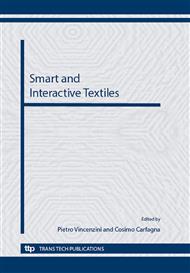p.59
p.65
p.71
p.77
p.83
p.90
p.96
p.102
p.112
Essential Building Blocks of Fibrous Transistors, Part I: Gate Layer
Abstract:
Abstract. During the last decade, research on intelligent textile systems progressed steadily. Today, science is focusing on full integration of electronics into textiles. E-textiles function like their rigid electronic companions but keep their textile properties. To interconnect components within the system, textile structures need to be equipped with electro-conductive properties. For flexible solar cells or fibrous transistors, electro-conductive coatings are applied. Transistors, acting as electrical switches, are essential for realizing fully integrated intelligent textile systems. By electroless deposition of pyrrole and copper on polyester fibres, conductivity is achieved. A DC conductive gate electrode is designed. In this paper, the development of the gate layer within the fibrous transistor is described. Ideal pH and optimal reaction time are determined as well as the effect of variation in fibre diameter is investigated. A reproducible polypyrrole layer has been obtained. Ideal reaction time was 180 minutes at a temperature of 278K. The electroless copper coating process on the polypyrrole layer showed optimal results when the substrate was immersed into the plating bath coated for 6 minutes at a pH of 13. Analysis through resistance measurements has been completed.
Info:
Periodical:
Pages:
83-89
Citation:
Online since:
September 2012
Price:
Сopyright:
© 2013 Trans Tech Publications Ltd. All Rights Reserved
Share:
Citation:


